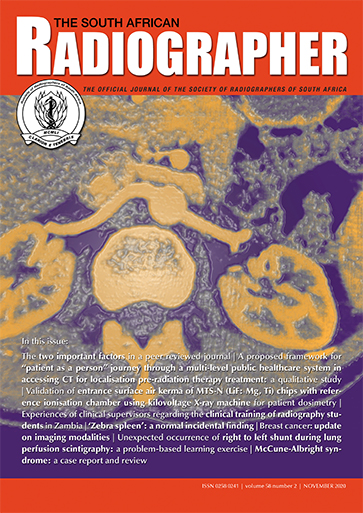Validation of entrance surface air kerma of MTS-N (LiF: Mg, Ti) chips with reference ionisation chamber using kilovoltage X-ray machine for patient dosimetry
Keywords:
thermoluminescent dosimeter, calibration, cesium-137, coefficient of determination, backscatter factorAbstract
Background. The use of ionisation chamber and thermoluminescent dosimeter (TLD) for patient dosimetry are well established.
Aim and objectives. The aim was to compare the entrance surface air kerma (ESAK) between MTS-N (LiF: Mg, Ti) chips and ionisa-tion chamber by exposing them to same dose. The purpose is to use the TL chips as a tool for patient dosimetry/audit in diagnostic radiology. In addition, homogeneity and element correction factor (ECF) of the selected chips were determined.
Material and methods. TL chips were annealed at 400°c for one hour and allowed to cool and were further heated to a temperature of 100°c for another two hour usings a TLD Furnace Type LAB-01/400. The calibrated DCT-10mm ionisation chamber was positioned on a plastic container filled with water, 10cm thick at source to image distance (SID) of 1m for a 10 × 10cm2 field size. The same procedure was used for the TL chips, which were carefully placed in a transparent nylon on the plastic container as well. Exposures were made to 10mGy. MagicMax software was used to display the ion-chamber ESAK. A RadPro Cube 400 manual TLD reader was used to determine corresponding TL signal and predetermined calibration factor (CF). The unexposed chips were subtracted from exposed ones and were multiplied with the appropriate back-scatter factor (BSF) to determine TL ESAK.
Results. There was good exposure reproducibility from the X-ray unit, with coefficient of variation (CV) of 0.12%. The maximum uniformity index of the chips was 24.18%, which was below the 30% limit. The ECF for the ten (10) selected TL chips ranged from 0.9-1.1, which was within accepted limit (0.8-1.2). The maximum deviation of the TL chips to the ion-chamber was -9%, which was < ± 10%, while 70% of the % deviation were < ± 5%. The mean dose of TL chips was 10.02±0.48mGy, with accuracy of 0.2%.
Conclusion. The MTS-N (LiF: Mg, Ti) chips from this study yielded positive results when compared to ionisation chamber measurement at low dose.
Lay abstract
A study was done using different ways of working out radiation dose.
Downloads
Published
Issue
Section
License
Copyright on all published material belongs to the Society of Radiographers of South Africa (SORSA).I hereby understand and declare that:
- All proprietary rights other than copyright are reserved to the authors, as well as the right to reproduce original figures and tables from this item in their future works, provided full credit is given to the original publication The South African Radiographer ISSN 0258 0241.
- In consideration of the reviewing and editing done by the editors of The South African Radiographer of the above named manuscript, the author/s hereby transfer, assign, or otherwise convey all copyright ownership world-wide, in all languages, to the Society of Radiographers of South Africa in the event that this manuscript is accepted for publication.
- If the manuscript has been commissioned by another person or organisation, or if it has been written as part of the duties of an employee, that full authorization has been given by the representative of the commissioning organisation or employer to be published in the The South African Radiographer.


